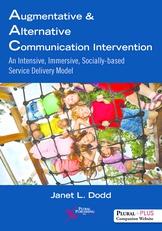Publication

Augmentative and Alternative Communication Intervention
An Intensive, Immersive, Socially Based Service Delivery Model
- Details:
- 288 pages, Illustrated (B/W), Softcover, 7 x 10" 1 lbs
- Included Media:
- Companion Website
- ISBN13:
- 978-1-59756-725-1
- Release Date:
- 06/30/2017
Overview
Augmentative and Alternative Communication Intervention: An Intensive, Immersive, Socially Based Delivery Model is ideal for school-based speech-language pathologists (SLPs) and an excellent resource for interventionists (special education teachers, ABA therapists) and SLPs working in other settings who wish to develop an intensive, immersive Augmentative and Alternative Communication (AAC)-based intervention through a three-phase intervention process: assessment, intervention planning, and intervention implementation.
Written by an SLP who has worked in a public school setting and saw to the application of theory to practice, the text provides detailed information regarding working with children who have complex communication needs and the background knowledge necessary for successful implementation of the intervention approach. Included are considerations for vocabulary selection for the beginning communicator, how to create a symbolically rich environment, detailed intervention approaches, and progress monitoring strategies that establish appropriate, measurable goals. AAC will no longer be an alternative means of communication but a best practice means of teaching communication in the SLP's or interventionist's repertoire.
Making the leap from the theoretical to the practical, this essential book:
- Describes the intervention needs of children with complex communication needs and the limitations of current approaches (e.g., PECS, Milieu Training, Functional Communication Training).
- Operationally defines the goal of AAC intervention, discussing its complexities, including the limitations of a pull-out model.
- Introduces the Intensive, Immersive, Socially Based Approach to Intervention and briefly describes each phase of the intervention process.
- Discusses how AAC assessments differ from traditional assessments of speech and language skills, as well as provides an overview of different assessment models and their contribution to the intervention process.
- Examines the importance of training support staff to key components of this intervention model.
- Contains information on the application of language-based intervention strategies to AAC.
- Talks about the importance of progress monitoring and how to use functional communication measures and communication sampling, a new and innovative technique developed by the author, to monitor progress.
- Provides example lesson plans and example goals addressing each area of communicative competence.
- Includes a PluralPlus companion website with downloadable forms for data collection and a sample letter to send home to parents.
Preface
Acknowledgments
Chapter 1. Introduction
Chapter 2. Intervention as a Process
Chapter 3. Assessment Phase
Chapter 4. Intervention Planning Phase
Chapter 5. Intervention Implementation Phase
Chapter 6. Progress Monitoring
Chapter 7. Case Examples
Appendix A. Topics for Communication Guide Training
Appendix B. Common Core Vocabulary
Appendix C. Books with Repetitive Phrases
Appendix D. Adapted Stories: Creating Manageable Stories for Students with CCNs
Appendix E. Sample Activities and Lessons
Appendix F. Contents of the PluralPlus Companion Website
Index
About The Author
Janet L. Dodd, SLP-D, CCC-SLP, has over 25 years' experience working as a school-based speech-language pathologist. Dr. Dodd blends her experiences as a school-based speech-language pathologist (SLP) with her passion for the field into her role of teaching aspiring clinicians. As a school-based SLP, she recognized the inadequacies of current practices in meeting the needs of her students who were unable to use oral language as a functional means of communication. Utilizing her experience and the professional networks she developed working as a speech-language pathologist in a public school setting, she established Chapman University's All About Communication (AAC) Camp. Initially developed as a means to provided graduate speech-language pathology student clinicians hands-on experience using technology to teach students with complex communication needs to communicate, AAC Camp has evolved into an exemplary service delivery model to apply when working with students with the most complex communication needs. Another area of particular interest that evolved mostly out of necessity in working with high-profile students was the practice of providing thorough, educationally relevant, and legally defensible assessments for children with suspected autism spectrum disorder (ASD) diagnoses. Through her experience as a school-based SLP in collaboration with colleagues representing various disciplines, she developed the Comprehensive Multi-disciplinary Assessment Protocols for ASD (CMAPS). The CMAPS is a series of assessment protocols that can be used by school-based teams to guide the development of comprehensive and legally defensible assessment plans. Her research and clinical experience focuses on the use of classroom-based interventions to address the unique challenges experienced by children with ASD, including curriculum-relevant social skills interventions and the use of technology to facilitate communication in children with more severe forms of autism. She has published numerous articles and frequently presents on topics relevant to speech-language pathologists working with children with ASD in school settings.
Related Titles
Augmentative and Alternative Communication
320 pages, Illustrated (B/W), Softcover, 7 x 10"
Hearing Assistive and Access Technology
Samuel R. Atcherson, Clifford A. Franklin, Laura Smith-Olinde
320 pages, Illustrated (B/W), Softcover, 7 x 10"
Patient-Provider Communication
Edited by: Sarah W. Blackstone, David R. Beukelman, Kathryn M. Yorkston
352 pages, Illustrated (B/W), Softcover, 7 x 10"
Augmentative and Alternative Communication in Acute and Critical Care Settings
Richard R. Hurtig, Ph.D., Debora Downey, CCC-SLP
224 pages, Illustrated (B/W), Softcover, 7 x 10"
Purchasers of this book receive complimentary access to supplementary materials hosted on a PluralPlus companion website.
Materials:
- Vocabulary worksheet
- Skills checklist
- Inventory
- Sample forms
- Progress report
- Data collection form activity
- Sample Letter
To access the materials, log in to the website using the URL and Access Code located inside the front cover of your copy of Augmentative and Alternative Communication Intervention: An Intensive, Immersive, Socially Based Service Delivery Model.













